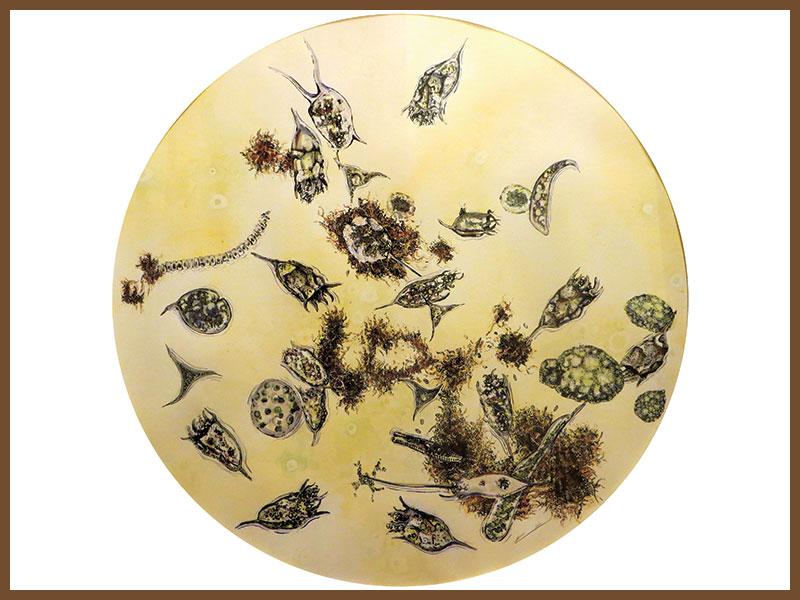Art, meet science
In Phytoplankton: A Studio in the Woods (pictured), Pippin Frisbie-Calder, a graduate student in printmaking in the Newcomb Art Department at Tulane, accomplishes the goal of intertwining the worlds of science and art. Completed through a combined process of pen-and-ink, screenprinting and watercolor, Frisbie-Calder succeeds at uncovering the realm in which microscopic marine plants from the wetlands of Louisiana dwell.
Phytoplankton is a spherical presentation, allowing viewers to observe what a scientist would see under the circular lens of a microscope.
Frisbie-Calder said the process to obtain the microorganisms was quite challenging. Samples were collected from nearby lakes, bayous and ponds and taken to a lab for a magnified view.
“It’s like watching a sci-fi movie unfold before you with whirling flagella and undulating cilia.”
Pippin Frisbie-Calder
“I didn’t know much about these organisms prior to this project,” she said. “I’ll be honest, I still need help identifying many that I chose to draw. This is partially my artistic take on what I was seeing as well as a distinct lack of resources available around Louisiana’s freshwater microbes. I used my artistic license to condense many of these organisms collected from different images.”
The microorganisms pictured came from the same body of water, giving a regional specificity to the artwork.
“Each organism has amazingly different life forms,” she wrote in a blog post at the height of the 2015 project. “It’s like watching a sci-fi movie unfold before you with whirling flagella and undulating cilia.”
With help from Tim McLean, a professor of practice in the Tulane Department of Ecology and Evolutionary Biology, Frisbie-Calder retrieved water samples containing the microorganisms using a phytoplankton net specifically designed to capture tiny organisms in its fine mesh.
McLean and Frisbie-Calder’s pairing was not accidental. Phytoplankton is one of several works by Frisbie-Calder to come from a six-week-long “Flint and Steel” residency at A Studio in the Woods, an artists’ retreat and learning center.
A Studio in the Woods is a component of the new ByWater Institute. A Studio in the Woods is located on the Mississippi River bank in a bottomland hardwood forest within New Orleans city limits.
The goal of the residency is to pair artists and Tulane faculty members so that they may inspire each other, excite the public and ignite social change. “Flint and Steel” refers to sparking cross-disciplinary combustion through these collaborations.

